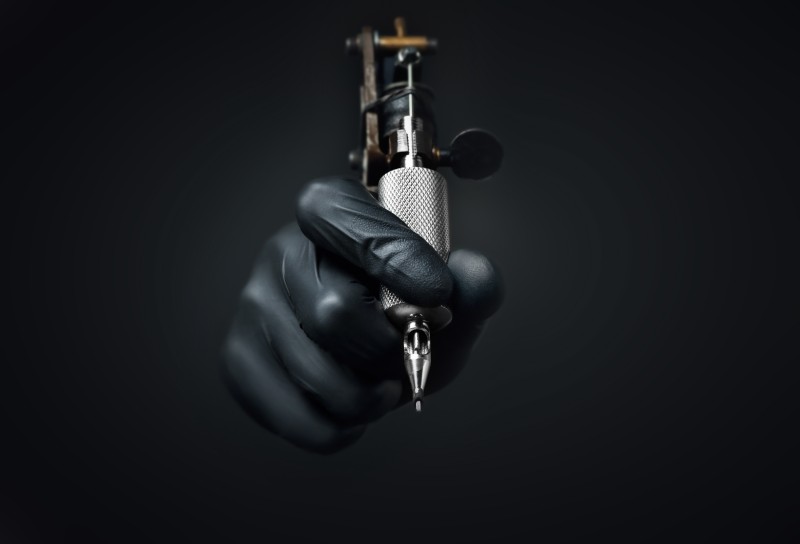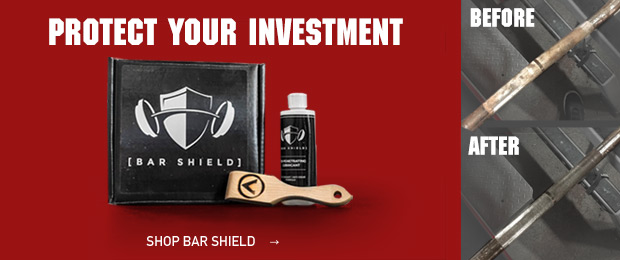
Getting tattooed isn’t the end of the process. After your new ink is applied, your tattoo artist will give you a set of steps and procedures you need to follow to make sure your skin heals properly and the tattoo comes out looking its best (with colors still vibrant and the line work exactly as it should be).
Your aftercare routine will make the healing process seem a bit finicky. One wrong move could ruin your tattoo; and it’s true, bad aftercare can cause some noticeable damage to your design if you’re extremely reckless.
RELATED: Stop Compensating Early
If you’re a powerlifter, you’re probably wondering if you can still take part in your training and competitions without ruining your new tattoo. Could all that stretching, flexing, and straining you do when pushing your muscles to the limit affect your ink?

alexzaitsev © 123rf.com
Below is an important list of things you should and should not do when it comes to powerlifting with a new tattoo:
DON’T work out the morning before getting your tattoo. I know, your appointment with the tattoo artist probably isn’t on one of your rest days, but you will want to make an exception for this one. The reason is simple: When you come out of the gym, your muscles are going to be sore. Tattooing hurts. Sore muscles hurt, too. And tattooing on sore muscles? It can be practically unbearable.
DO apply tattoo lotion. Most tattoo lotions blend natural oils with a variety of other ingredients to help your skin heal more quickly, keep it moisturized, and protect it from damage. The extra protection it gives you is important, even if all you plan to do is sit around while your tattoo heals. It’s downright essential if you’re going to put it through a lot of strain by lifting. There are many things you can apply to a new tattoo to make sure it doesn’t dry out and go tight, from specialized tattoo balms containing many ingredients and vitamins, right down to organic products such as coconut oil and cocoa butter.
DON’T work out for the first 24 hours. Try pushing it to 48 hours if you’re comfortable doing that. Your first day or two of healing are the most crucial. You’ll want to avoid any additional bleeding or damage to the skin and give your tattoo the best head start it can get. Part of letting your tattoo heal is making sure your body concentrates all of its resources on repairing the damage. If your body has to devote a lot of its energy to recover after a workout, it won’t have enough resources left to give your skin what it needs to get into repair mode.
DO keep your tattoo out of the sun. Part of your aftercare routine will involve some sun protection, either by covering up your tattoo or applying sunblock or some other form of protection. If you train or lift outdoors, consider finding a temporary indoor spot to train instead. Your garage will do, and if you don’t have one, you can check out a local gym (most of them will let you do a trial membership, which will probably last long enough for your tattoo to finish healing). If you do have to train outdoors or you’re going to compete in an outdoor event, do your best to keep the tattoo covered. A long-sleeved shirt might not be the best way to show off the physique you’ve been working on, but it’s the best way to protect your tattoo.
DON’T flex your tattooed skin more than you have to. Tattoos can fade more quickly in places where the skin gets flexed a lot (think elbows, knuckles, and knees). If you’re going to squat and lift as part of your training, make sure you take care not to flex those areas too much in your downtime. Of course, how much your tattoo gets flexed all depends on where it is on your body.
DO cover up. Look at the placement of your tattoo. Will it come into contact with the bar when you’re lifting? Will you be pushing your tattoo against anything else while you’re lifting? If so, keep it covered with a tight-fitting shirt or pair of shorts. However, don’t restrict the tattoo under tight clothing for too long, as sweat and heat can cause harmful bacteria to grow around the open wound created by the tattooing process, potentially leading to infections that can permanently damage your tattoo if you don’t treat them quickly enough.
LISTEN: Table Talk Podcast Clip — The Big Misconception About Chuck Vogelpohl
DON’T get a tattoo across your upper back if you can help it. Wait until you’re OK taking a break from lifting to get one in this area. When you’re placing the bar against your back with all that weight on it, it could do some damage to areas of skin that are still in the process of healing, which could compromise the way your tattoo comes out. For the most part, it will still be fine, but you are taking a bit of a chance when you’re putting that much stress on your tattoo.
DO ask your tattoo artist for advice. They’re your best resource in all of this. They know exactly what kind of tattoo you have, where it’s placed, and what your skin is like. If you have any concerns, go to them first.
DON’T worry about big future gains ruining the look of your tattoo. Spend enough time on bodybuilding/weightlifting forums, and the question will come up: “If I get really beefed up, will it stretch out my tattoo?” The short answer is no. You can build muscle all you want and your tattoo will look the same. The extra definition and increased size of your muscles won’t affect the clarity or appearance of your tattoo – all they’re going to do is make you look bigger and better.
DO accept that your tattoo may temporarily affect performance. Let’s face it, if you’ve just got a new tattoo that you’re trying your hardest to look after, you’re going to be actively trying to not ruin it while you’re lifting. You may be moving slightly different so you don’t cause the tattooed area to rub, or you might be wearing different clothing you don’t really like lifting in because it’s not restricting your tattoo as much, or you might just be more mentally focused on your tattoo more than your performance. All of these reasons can lead to lower lifts, so be wary of this before entering into any important competitions only days after getting a new tattoo.
Conclusion
Getting a new tattoo doesn’t mean you have to throw the bar down and not step foot in a gym for the next two months. What it does mean, though, is that you need to make some compromises and ensure you don’t do anything reckless for the first couple of months.
By timing your tattoo session well and ensuring you stay on the sensible side of caution when you do walk back into the gym, you greatly minimize the risk of causing any lasting damage to the new ink that you’ve probably been waiting years to finally get.
Header image courtesy of Ольга Колбакова © 123rf.com
Dan Hunter, a self-confessed ink addict and studier of all forms of tattooing for over 10 years, is the chief editor at AuthorityTattoo.com — a website that prides itself on being one of the most well-respected and trusted resources for tattoos and piercings on the internet. While no longer as active in the tattooing community, Dan still strives to relentlessly improve his knowledge on the various methods of tattooing throughout the world and is here to help educate, teach, and advise readers on all things tattoo-related.











Anyways, I just got my first-ever tattoo, and even though I've read this article multiple times and formatted it, this is super nice to come back to for more information. Again, even though I'm not doing the Big Three lifts, this will be incredibly useful when I train with Lily and Margaret tomorrow.
All of this advice is useful for more gen-pop people like myself, too. Awesome article, and good work.
JCHOMIEBOY STRONGER BACK HEAD STATES NORTH CAROLINA RYAL WHITE RED 131HERBER HILLS DRIVE HAYESVILLE NORTH CAROLINA 28904 321-820-7505